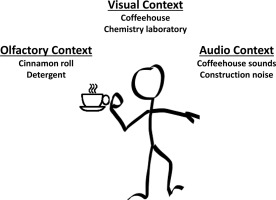Food Research International ( IF 7.0 ) Pub Date : 2018-04-18 , DOI: 10.1016/j.foodres.2018.04.024 Rebecca Liu , Mackenzie Hannum , Christopher T. Simons

|
To explore how contextual information streams are processed and prioritized during consumer studies, we manipulated the congruency of visual, auditory and olfactory cues using immersive technologies and assessed the impact on context recall, evaluation time, and preference and liking for cold brewed coffee. Each consumer (n = 50) was exposed to two identical control conditions, a visually incongruent condition, an auditory incongruent condition, an olfactory incongruent condition, and an all-incongruent condition. The control condition simulated a coffeehouse environment complete with the sights, sounds and smells commonly experienced in that venue. A laboratory setting, construction noise, and laundry detergent represented the individual incongruent visual, auditory, and aroma streams, respectively. Results revealed that olfactory information had a lesser priority than visual or auditory information in the simulated environments when assessed by subject's ability to recall encountered information streams. Panelists also spent more time evaluating coffees in the first presented control condition compared to the incongruent conditions or the repeated control condition. Finally, although the averaged combined liking score for subjects' least to most preferred coffees was significantly lowered in the all-incongruent condition compared to the control condition, this decrease was not substantial. Understanding how the saliency of contextual information influences consumer behavior and attention can inform immersive testing methodologies.
中文翻译:

使用沉浸式技术探索一致和不一致的上下文提示对上下文回想,产品评估时间以及消费者享乐测试期间的喜好和喜好的影响
为了探索在消费者研究期间如何处理上下文信息流并确定优先级,我们使用沉浸式技术操纵了视觉,听觉和嗅觉提示的一致性,并评估了对上下文回忆,评估时间,偏好和喜欢冷煮咖啡的影响。每个消费者(n = 50)暴露于两个相同的对照条件下,即视觉上不一致的条件,听觉上不一致的条件,嗅觉上不一致的条件和完全不一致的条件。控制条件模拟了一个咖啡馆环境,并结合了该场所常见的景象,声音和气味。实验室环境,建筑噪音和洗衣粉分别代表了不协调的视觉,听觉和香气流。结果表明,在通过受试者回忆遇到的信息流的能力进行评估时,在模拟环境中,嗅觉信息的优先级低于视觉或听觉信息。与不一致的条件或重复的控制条件相比,与会人员还花了更多时间评估第一个提出的控制条件下的咖啡。最后,尽管在全非一致条件下,受试者最不喜欢最喜欢的咖啡的平均综合喜欢评分明显低于对照条件,但这种降低并不明显。了解上下文信息的显着性如何影响消费者的行为和注意力可以为沉浸式测试方法提供信息。











































 京公网安备 11010802027423号
京公网安备 11010802027423号